Enterprise Planning and Implementation for Nestle: Upgrading ERP System and CRM Integration
VerifiedAdded on 2023/06/14
|11
|2659
|473
AI Summary
This article discusses the planning and implementation of upgrading the ERP system and CRM integration for Nestle. It covers the internal and external change drivers and assessments, the current and future state of the organization, and the strategies for customer journey and change management. The article also provides recommendations for using cloud ERP and the latest developments of CRM for Nestle.
Contribute Materials
Your contribution can guide someone’s learning journey. Share your
documents today.
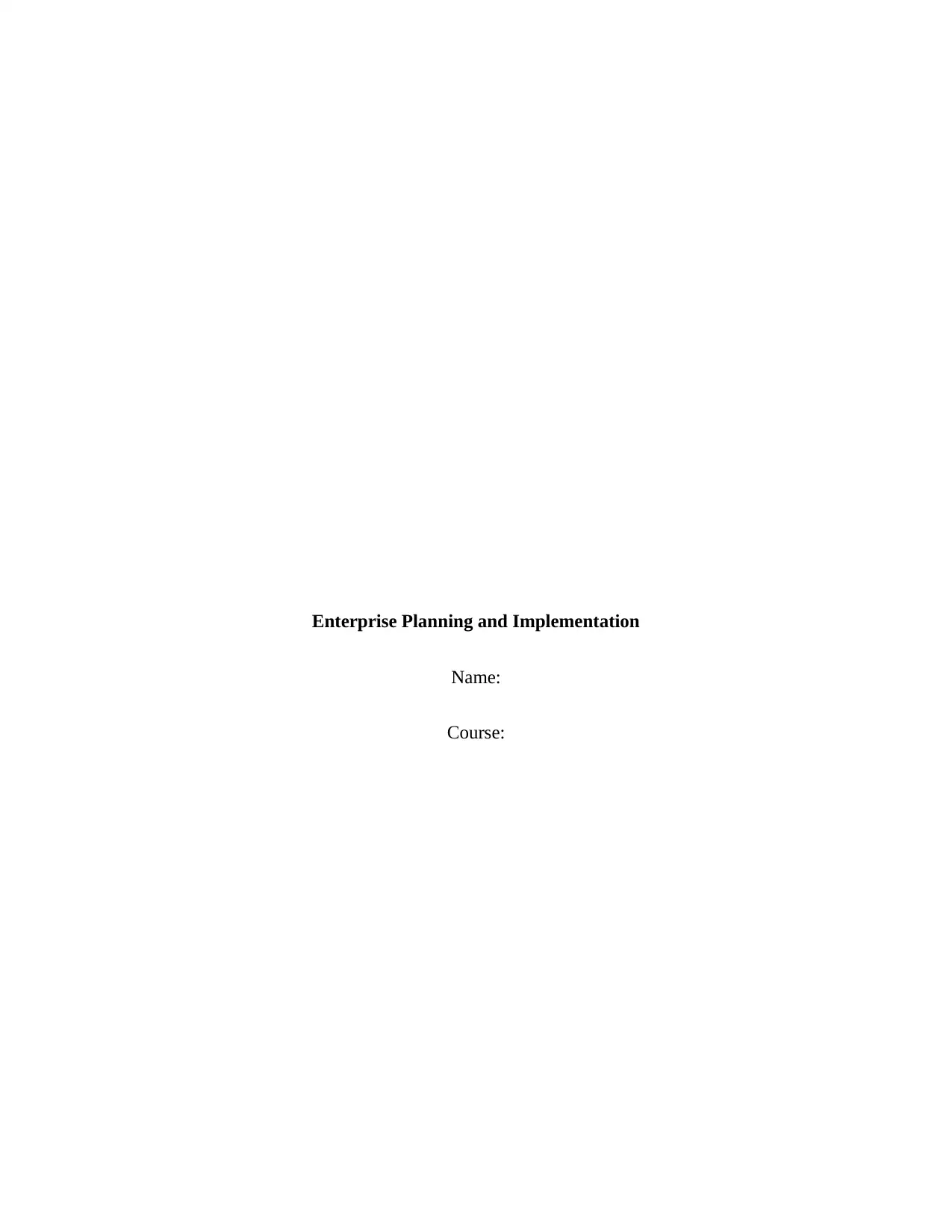
Enterprise Planning and Implementation
Name:
Course:
Name:
Course:
Secure Best Marks with AI Grader
Need help grading? Try our AI Grader for instant feedback on your assignments.
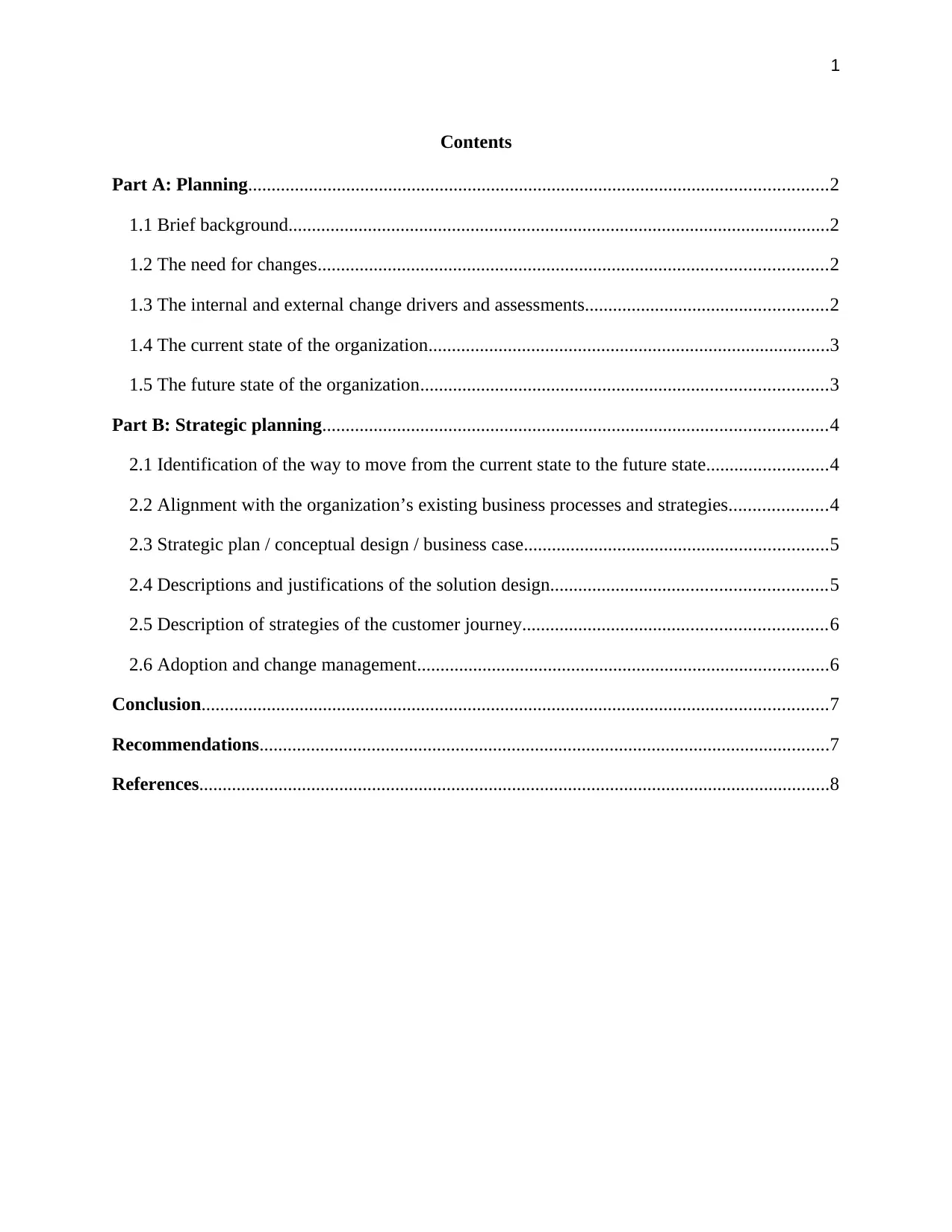
1
Contents
Part A: Planning............................................................................................................................2
1.1 Brief background....................................................................................................................2
1.2 The need for changes.............................................................................................................2
1.3 The internal and external change drivers and assessments....................................................2
1.4 The current state of the organization......................................................................................3
1.5 The future state of the organization.......................................................................................3
Part B: Strategic planning............................................................................................................4
2.1 Identification of the way to move from the current state to the future state..........................4
2.2 Alignment with the organization’s existing business processes and strategies.....................4
2.3 Strategic plan / conceptual design / business case.................................................................5
2.4 Descriptions and justifications of the solution design...........................................................5
2.5 Description of strategies of the customer journey.................................................................6
2.6 Adoption and change management........................................................................................6
Conclusion......................................................................................................................................7
Recommendations..........................................................................................................................7
References.......................................................................................................................................8
Contents
Part A: Planning............................................................................................................................2
1.1 Brief background....................................................................................................................2
1.2 The need for changes.............................................................................................................2
1.3 The internal and external change drivers and assessments....................................................2
1.4 The current state of the organization......................................................................................3
1.5 The future state of the organization.......................................................................................3
Part B: Strategic planning............................................................................................................4
2.1 Identification of the way to move from the current state to the future state..........................4
2.2 Alignment with the organization’s existing business processes and strategies.....................4
2.3 Strategic plan / conceptual design / business case.................................................................5
2.4 Descriptions and justifications of the solution design...........................................................5
2.5 Description of strategies of the customer journey.................................................................6
2.6 Adoption and change management........................................................................................6
Conclusion......................................................................................................................................7
Recommendations..........................................................................................................................7
References.......................................................................................................................................8
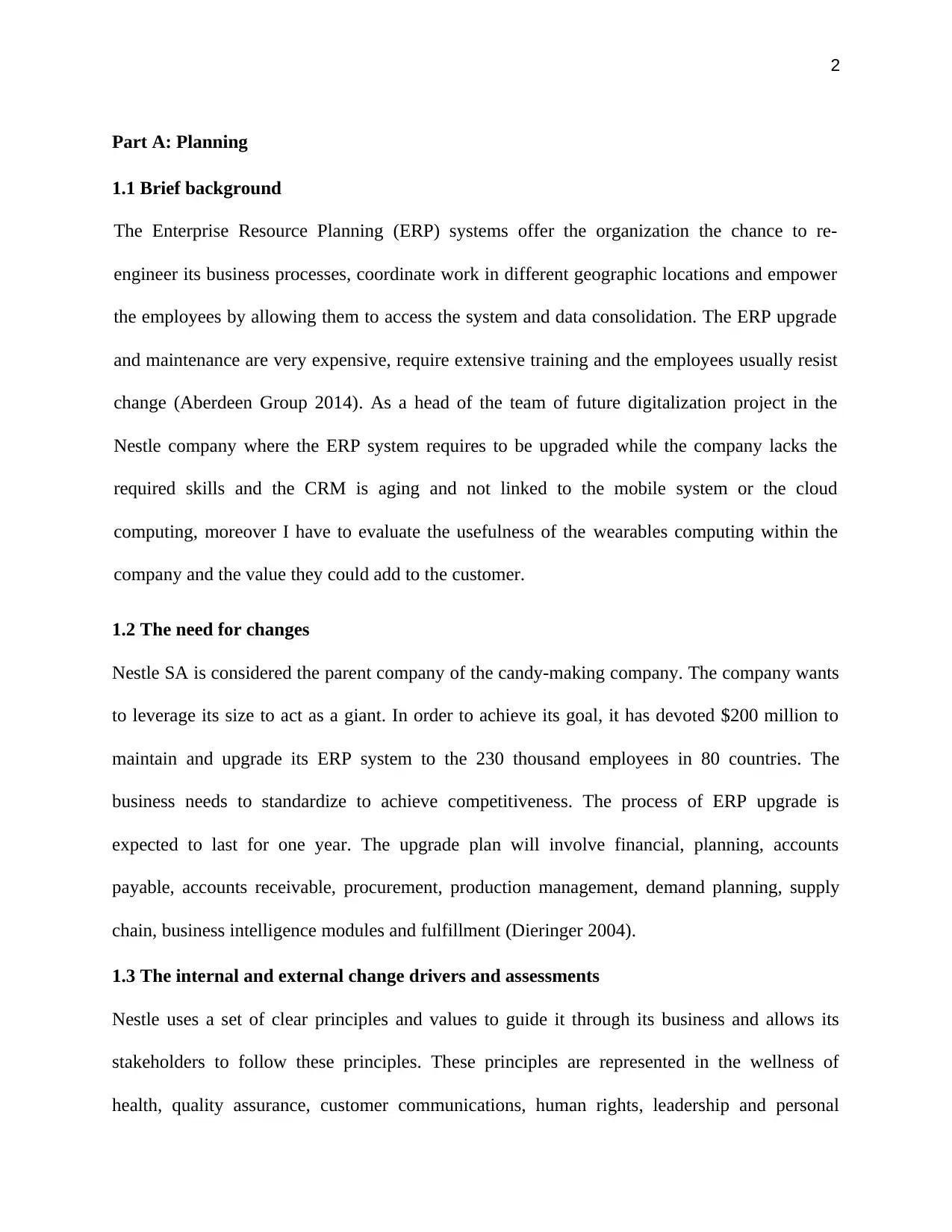
2
Part A: Planning
1.1 Brief background
The Enterprise Resource Planning (ERP) systems offer the organization the chance to re-
engineer its business processes, coordinate work in different geographic locations and empower
the employees by allowing them to access the system and data consolidation. The ERP upgrade
and maintenance are very expensive, require extensive training and the employees usually resist
change (Aberdeen Group 2014). As a head of the team of future digitalization project in the
Nestle company where the ERP system requires to be upgraded while the company lacks the
required skills and the CRM is aging and not linked to the mobile system or the cloud
computing, moreover I have to evaluate the usefulness of the wearables computing within the
company and the value they could add to the customer.
1.2 The need for changes
Nestle SA is considered the parent company of the candy-making company. The company wants
to leverage its size to act as a giant. In order to achieve its goal, it has devoted $200 million to
maintain and upgrade its ERP system to the 230 thousand employees in 80 countries. The
business needs to standardize to achieve competitiveness. The process of ERP upgrade is
expected to last for one year. The upgrade plan will involve financial, planning, accounts
payable, accounts receivable, procurement, production management, demand planning, supply
chain, business intelligence modules and fulfillment (Dieringer 2004).
1.3 The internal and external change drivers and assessments
Nestle uses a set of clear principles and values to guide it through its business and allows its
stakeholders to follow these principles. These principles are represented in the wellness of
health, quality assurance, customer communications, human rights, leadership and personal
Part A: Planning
1.1 Brief background
The Enterprise Resource Planning (ERP) systems offer the organization the chance to re-
engineer its business processes, coordinate work in different geographic locations and empower
the employees by allowing them to access the system and data consolidation. The ERP upgrade
and maintenance are very expensive, require extensive training and the employees usually resist
change (Aberdeen Group 2014). As a head of the team of future digitalization project in the
Nestle company where the ERP system requires to be upgraded while the company lacks the
required skills and the CRM is aging and not linked to the mobile system or the cloud
computing, moreover I have to evaluate the usefulness of the wearables computing within the
company and the value they could add to the customer.
1.2 The need for changes
Nestle SA is considered the parent company of the candy-making company. The company wants
to leverage its size to act as a giant. In order to achieve its goal, it has devoted $200 million to
maintain and upgrade its ERP system to the 230 thousand employees in 80 countries. The
business needs to standardize to achieve competitiveness. The process of ERP upgrade is
expected to last for one year. The upgrade plan will involve financial, planning, accounts
payable, accounts receivable, procurement, production management, demand planning, supply
chain, business intelligence modules and fulfillment (Dieringer 2004).
1.3 The internal and external change drivers and assessments
Nestle uses a set of clear principles and values to guide it through its business and allows its
stakeholders to follow these principles. These principles are represented in the wellness of
health, quality assurance, customer communications, human rights, leadership and personal
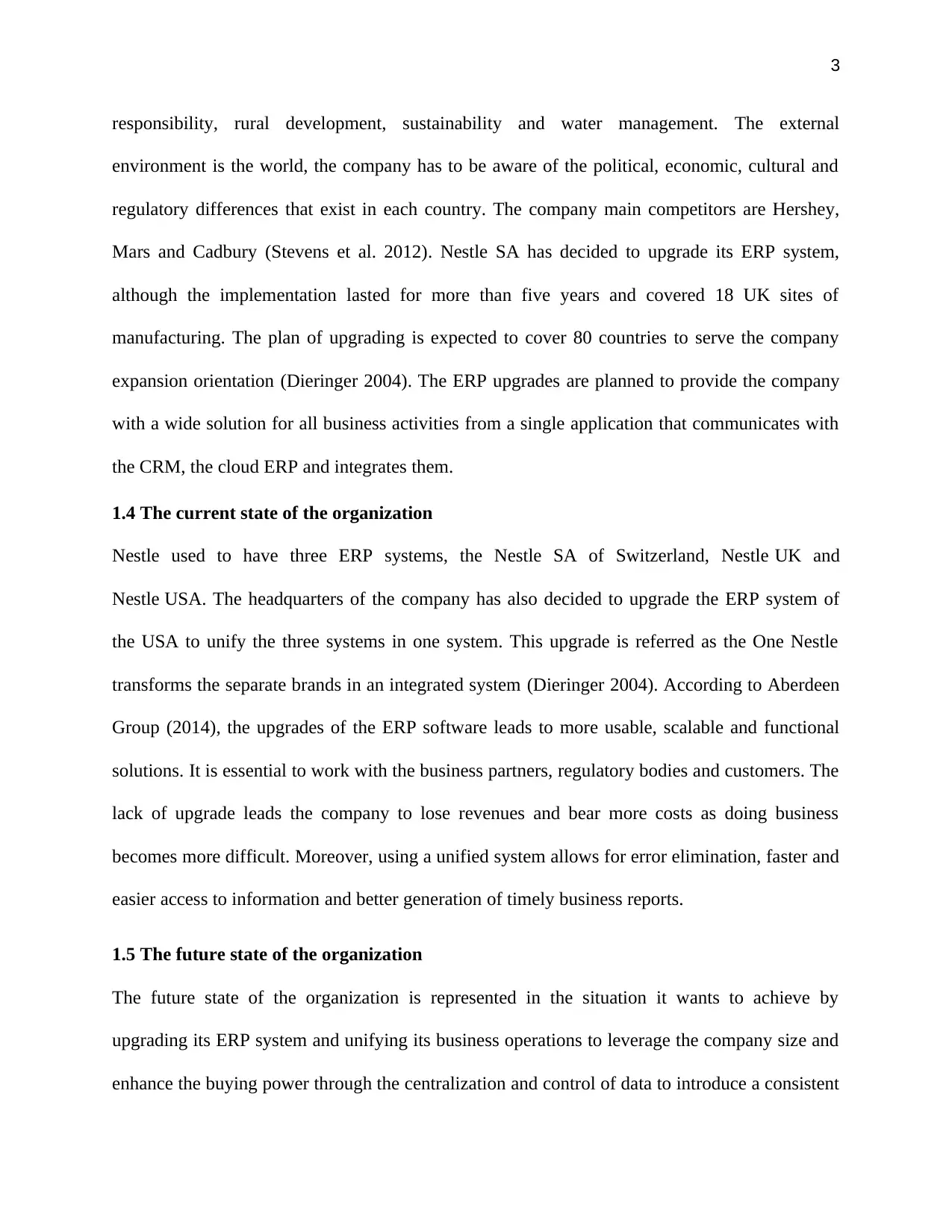
3
responsibility, rural development, sustainability and water management. The external
environment is the world, the company has to be aware of the political, economic, cultural and
regulatory differences that exist in each country. The company main competitors are Hershey,
Mars and Cadbury (Stevens et al. 2012). Nestle SA has decided to upgrade its ERP system,
although the implementation lasted for more than five years and covered 18 UK sites of
manufacturing. The plan of upgrading is expected to cover 80 countries to serve the company
expansion orientation (Dieringer 2004). The ERP upgrades are planned to provide the company
with a wide solution for all business activities from a single application that communicates with
the CRM, the cloud ERP and integrates them.
1.4 The current state of the organization
Nestle used to have three ERP systems, the Nestle SA of Switzerland, Nestle UK and
Nestle USA. The headquarters of the company has also decided to upgrade the ERP system of
the USA to unify the three systems in one system. This upgrade is referred as the One Nestle
transforms the separate brands in an integrated system (Dieringer 2004). According to Aberdeen
Group (2014), the upgrades of the ERP software leads to more usable, scalable and functional
solutions. It is essential to work with the business partners, regulatory bodies and customers. The
lack of upgrade leads the company to lose revenues and bear more costs as doing business
becomes more difficult. Moreover, using a unified system allows for error elimination, faster and
easier access to information and better generation of timely business reports.
1.5 The future state of the organization
The future state of the organization is represented in the situation it wants to achieve by
upgrading its ERP system and unifying its business operations to leverage the company size and
enhance the buying power through the centralization and control of data to introduce a consistent
responsibility, rural development, sustainability and water management. The external
environment is the world, the company has to be aware of the political, economic, cultural and
regulatory differences that exist in each country. The company main competitors are Hershey,
Mars and Cadbury (Stevens et al. 2012). Nestle SA has decided to upgrade its ERP system,
although the implementation lasted for more than five years and covered 18 UK sites of
manufacturing. The plan of upgrading is expected to cover 80 countries to serve the company
expansion orientation (Dieringer 2004). The ERP upgrades are planned to provide the company
with a wide solution for all business activities from a single application that communicates with
the CRM, the cloud ERP and integrates them.
1.4 The current state of the organization
Nestle used to have three ERP systems, the Nestle SA of Switzerland, Nestle UK and
Nestle USA. The headquarters of the company has also decided to upgrade the ERP system of
the USA to unify the three systems in one system. This upgrade is referred as the One Nestle
transforms the separate brands in an integrated system (Dieringer 2004). According to Aberdeen
Group (2014), the upgrades of the ERP software leads to more usable, scalable and functional
solutions. It is essential to work with the business partners, regulatory bodies and customers. The
lack of upgrade leads the company to lose revenues and bear more costs as doing business
becomes more difficult. Moreover, using a unified system allows for error elimination, faster and
easier access to information and better generation of timely business reports.
1.5 The future state of the organization
The future state of the organization is represented in the situation it wants to achieve by
upgrading its ERP system and unifying its business operations to leverage the company size and
enhance the buying power through the centralization and control of data to introduce a consistent
Secure Best Marks with AI Grader
Need help grading? Try our AI Grader for instant feedback on your assignments.
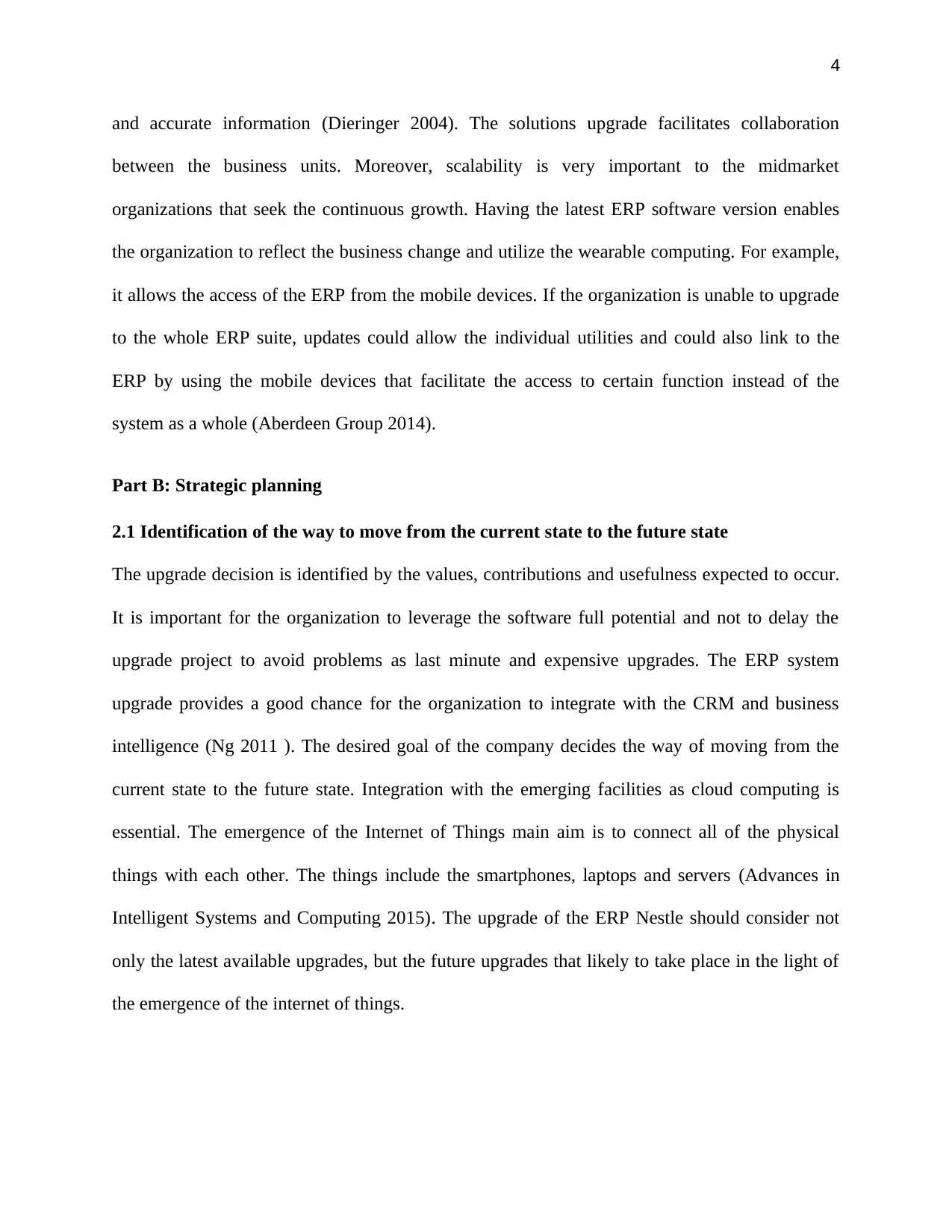
4
and accurate information (Dieringer 2004). The solutions upgrade facilitates collaboration
between the business units. Moreover, scalability is very important to the midmarket
organizations that seek the continuous growth. Having the latest ERP software version enables
the organization to reflect the business change and utilize the wearable computing. For example,
it allows the access of the ERP from the mobile devices. If the organization is unable to upgrade
to the whole ERP suite, updates could allow the individual utilities and could also link to the
ERP by using the mobile devices that facilitate the access to certain function instead of the
system as a whole (Aberdeen Group 2014).
Part B: Strategic planning
2.1 Identification of the way to move from the current state to the future state
The upgrade decision is identified by the values, contributions and usefulness expected to occur.
It is important for the organization to leverage the software full potential and not to delay the
upgrade project to avoid problems as last minute and expensive upgrades. The ERP system
upgrade provides a good chance for the organization to integrate with the CRM and business
intelligence (Ng 2011 ). The desired goal of the company decides the way of moving from the
current state to the future state. Integration with the emerging facilities as cloud computing is
essential. The emergence of the Internet of Things main aim is to connect all of the physical
things with each other. The things include the smartphones, laptops and servers (Advances in
Intelligent Systems and Computing 2015). The upgrade of the ERP Nestle should consider not
only the latest available upgrades, but the future upgrades that likely to take place in the light of
the emergence of the internet of things.
and accurate information (Dieringer 2004). The solutions upgrade facilitates collaboration
between the business units. Moreover, scalability is very important to the midmarket
organizations that seek the continuous growth. Having the latest ERP software version enables
the organization to reflect the business change and utilize the wearable computing. For example,
it allows the access of the ERP from the mobile devices. If the organization is unable to upgrade
to the whole ERP suite, updates could allow the individual utilities and could also link to the
ERP by using the mobile devices that facilitate the access to certain function instead of the
system as a whole (Aberdeen Group 2014).
Part B: Strategic planning
2.1 Identification of the way to move from the current state to the future state
The upgrade decision is identified by the values, contributions and usefulness expected to occur.
It is important for the organization to leverage the software full potential and not to delay the
upgrade project to avoid problems as last minute and expensive upgrades. The ERP system
upgrade provides a good chance for the organization to integrate with the CRM and business
intelligence (Ng 2011 ). The desired goal of the company decides the way of moving from the
current state to the future state. Integration with the emerging facilities as cloud computing is
essential. The emergence of the Internet of Things main aim is to connect all of the physical
things with each other. The things include the smartphones, laptops and servers (Advances in
Intelligent Systems and Computing 2015). The upgrade of the ERP Nestle should consider not
only the latest available upgrades, but the future upgrades that likely to take place in the light of
the emergence of the internet of things.
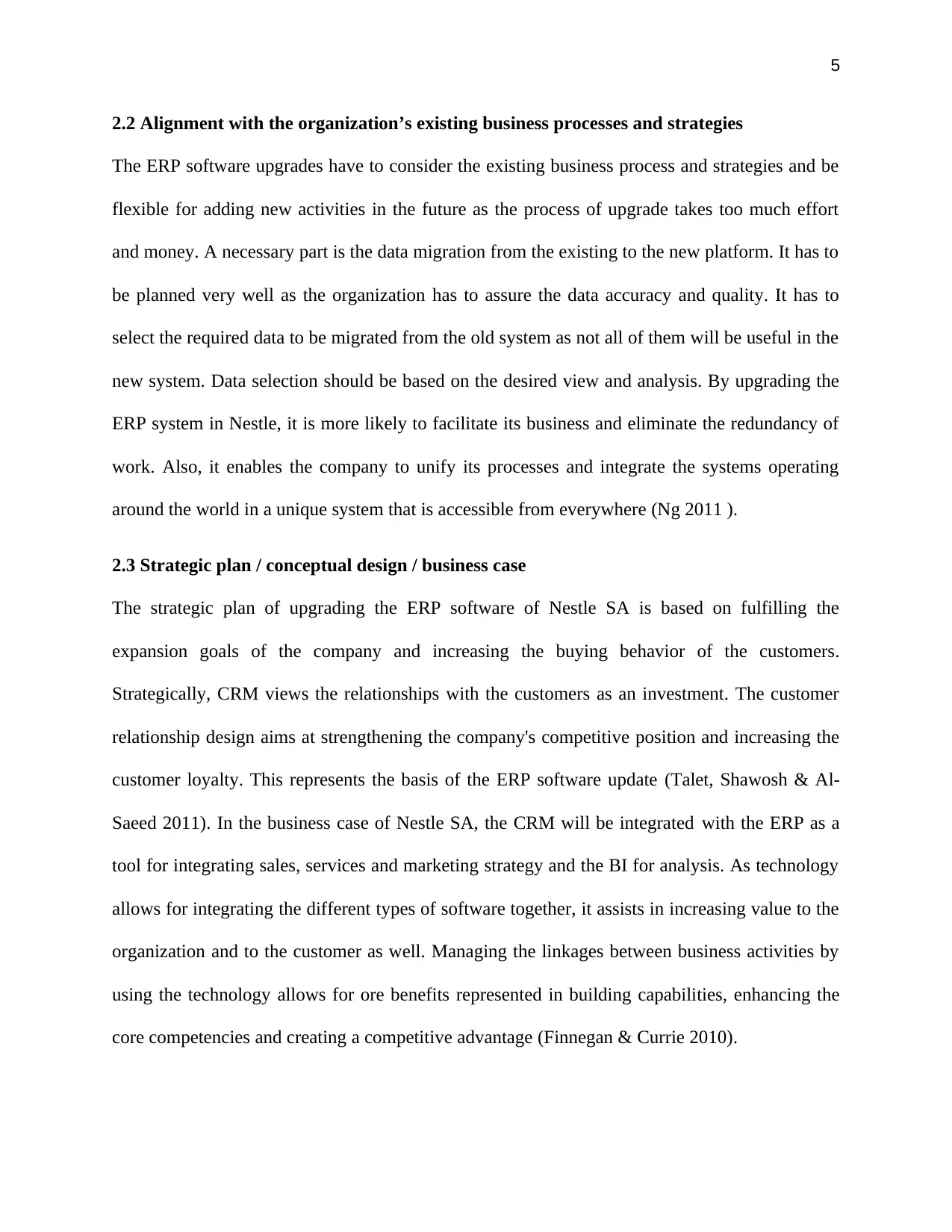
5
2.2 Alignment with the organization’s existing business processes and strategies
The ERP software upgrades have to consider the existing business process and strategies and be
flexible for adding new activities in the future as the process of upgrade takes too much effort
and money. A necessary part is the data migration from the existing to the new platform. It has to
be planned very well as the organization has to assure the data accuracy and quality. It has to
select the required data to be migrated from the old system as not all of them will be useful in the
new system. Data selection should be based on the desired view and analysis. By upgrading the
ERP system in Nestle, it is more likely to facilitate its business and eliminate the redundancy of
work. Also, it enables the company to unify its processes and integrate the systems operating
around the world in a unique system that is accessible from everywhere (Ng 2011 ).
2.3 Strategic plan / conceptual design / business case
The strategic plan of upgrading the ERP software of Nestle SA is based on fulfilling the
expansion goals of the company and increasing the buying behavior of the customers.
Strategically, CRM views the relationships with the customers as an investment. The customer
relationship design aims at strengthening the company's competitive position and increasing the
customer loyalty. This represents the basis of the ERP software update (Talet, Shawosh & Al-
Saeed 2011). In the business case of Nestle SA, the CRM will be integrated with the ERP as a
tool for integrating sales, services and marketing strategy and the BI for analysis. As technology
allows for integrating the different types of software together, it assists in increasing value to the
organization and to the customer as well. Managing the linkages between business activities by
using the technology allows for ore benefits represented in building capabilities, enhancing the
core competencies and creating a competitive advantage (Finnegan & Currie 2010).
2.2 Alignment with the organization’s existing business processes and strategies
The ERP software upgrades have to consider the existing business process and strategies and be
flexible for adding new activities in the future as the process of upgrade takes too much effort
and money. A necessary part is the data migration from the existing to the new platform. It has to
be planned very well as the organization has to assure the data accuracy and quality. It has to
select the required data to be migrated from the old system as not all of them will be useful in the
new system. Data selection should be based on the desired view and analysis. By upgrading the
ERP system in Nestle, it is more likely to facilitate its business and eliminate the redundancy of
work. Also, it enables the company to unify its processes and integrate the systems operating
around the world in a unique system that is accessible from everywhere (Ng 2011 ).
2.3 Strategic plan / conceptual design / business case
The strategic plan of upgrading the ERP software of Nestle SA is based on fulfilling the
expansion goals of the company and increasing the buying behavior of the customers.
Strategically, CRM views the relationships with the customers as an investment. The customer
relationship design aims at strengthening the company's competitive position and increasing the
customer loyalty. This represents the basis of the ERP software update (Talet, Shawosh & Al-
Saeed 2011). In the business case of Nestle SA, the CRM will be integrated with the ERP as a
tool for integrating sales, services and marketing strategy and the BI for analysis. As technology
allows for integrating the different types of software together, it assists in increasing value to the
organization and to the customer as well. Managing the linkages between business activities by
using the technology allows for ore benefits represented in building capabilities, enhancing the
core competencies and creating a competitive advantage (Finnegan & Currie 2010).
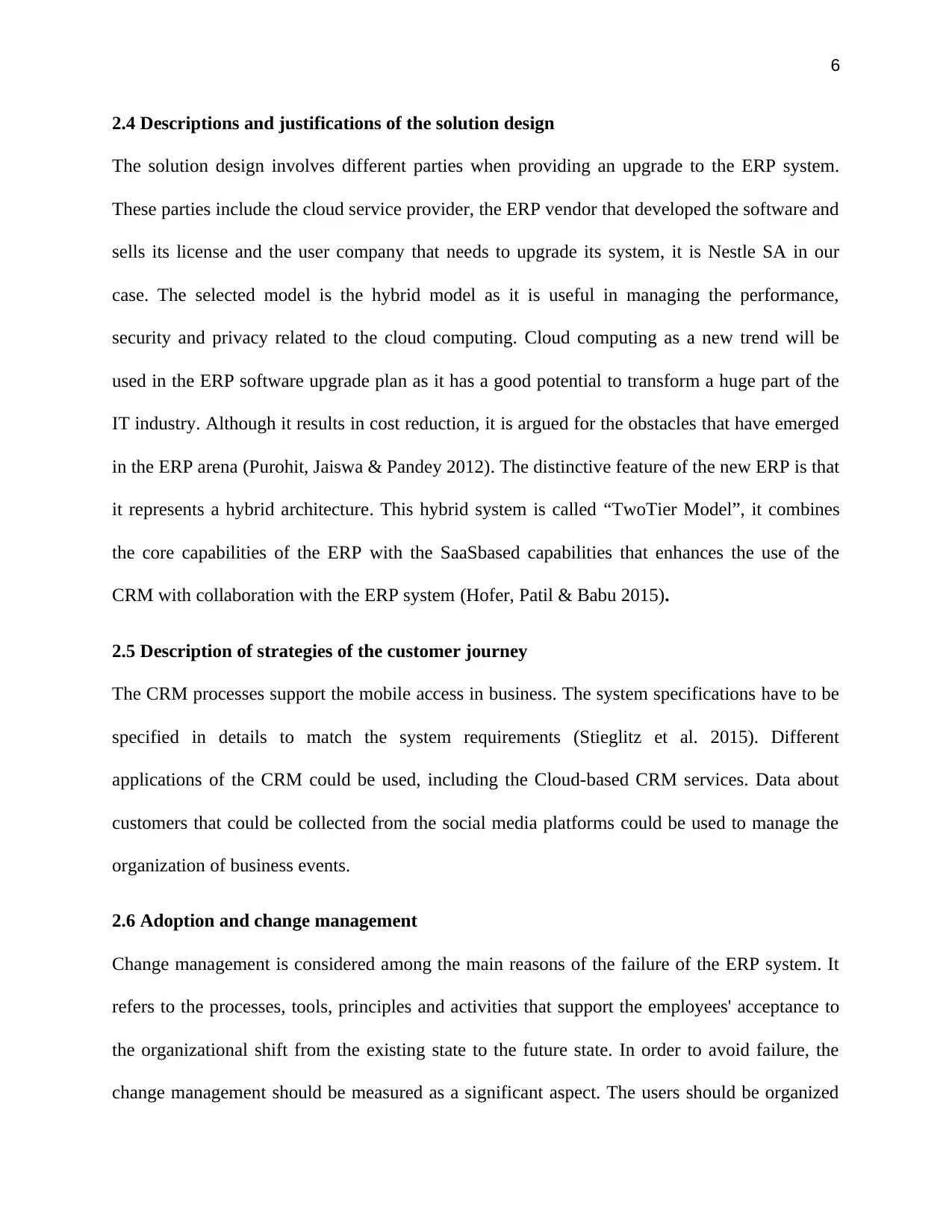
6
2.4 Descriptions and justifications of the solution design
The solution design involves different parties when providing an upgrade to the ERP system.
These parties include the cloud service provider, the ERP vendor that developed the software and
sells its license and the user company that needs to upgrade its system, it is Nestle SA in our
case. The selected model is the hybrid model as it is useful in managing the performance,
security and privacy related to the cloud computing. Cloud computing as a new trend will be
used in the ERP software upgrade plan as it has a good potential to transform a huge part of the
IT industry. Although it results in cost reduction, it is argued for the obstacles that have emerged
in the ERP arena (Purohit, Jaiswa & Pandey 2012). The distinctive feature of the new ERP is that
it represents a hybrid architecture. This hybrid system is called “TwoTier Model”, it combines
the core capabilities of the ERP with the SaaSbased capabilities that enhances the use of the
CRM with collaboration with the ERP system (Hofer, Patil & Babu 2015).
2.5 Description of strategies of the customer journey
The CRM processes support the mobile access in business. The system specifications have to be
specified in details to match the system requirements (Stieglitz et al. 2015). Different
applications of the CRM could be used, including the Cloud-based CRM services. Data about
customers that could be collected from the social media platforms could be used to manage the
organization of business events.
2.6 Adoption and change management
Change management is considered among the main reasons of the failure of the ERP system. It
refers to the processes, tools, principles and activities that support the employees' acceptance to
the organizational shift from the existing state to the future state. In order to avoid failure, the
change management should be measured as a significant aspect. The users should be organized
2.4 Descriptions and justifications of the solution design
The solution design involves different parties when providing an upgrade to the ERP system.
These parties include the cloud service provider, the ERP vendor that developed the software and
sells its license and the user company that needs to upgrade its system, it is Nestle SA in our
case. The selected model is the hybrid model as it is useful in managing the performance,
security and privacy related to the cloud computing. Cloud computing as a new trend will be
used in the ERP software upgrade plan as it has a good potential to transform a huge part of the
IT industry. Although it results in cost reduction, it is argued for the obstacles that have emerged
in the ERP arena (Purohit, Jaiswa & Pandey 2012). The distinctive feature of the new ERP is that
it represents a hybrid architecture. This hybrid system is called “TwoTier Model”, it combines
the core capabilities of the ERP with the SaaSbased capabilities that enhances the use of the
CRM with collaboration with the ERP system (Hofer, Patil & Babu 2015).
2.5 Description of strategies of the customer journey
The CRM processes support the mobile access in business. The system specifications have to be
specified in details to match the system requirements (Stieglitz et al. 2015). Different
applications of the CRM could be used, including the Cloud-based CRM services. Data about
customers that could be collected from the social media platforms could be used to manage the
organization of business events.
2.6 Adoption and change management
Change management is considered among the main reasons of the failure of the ERP system. It
refers to the processes, tools, principles and activities that support the employees' acceptance to
the organizational shift from the existing state to the future state. In order to avoid failure, the
change management should be measured as a significant aspect. The users should be organized
Paraphrase This Document
Need a fresh take? Get an instant paraphrase of this document with our AI Paraphraser
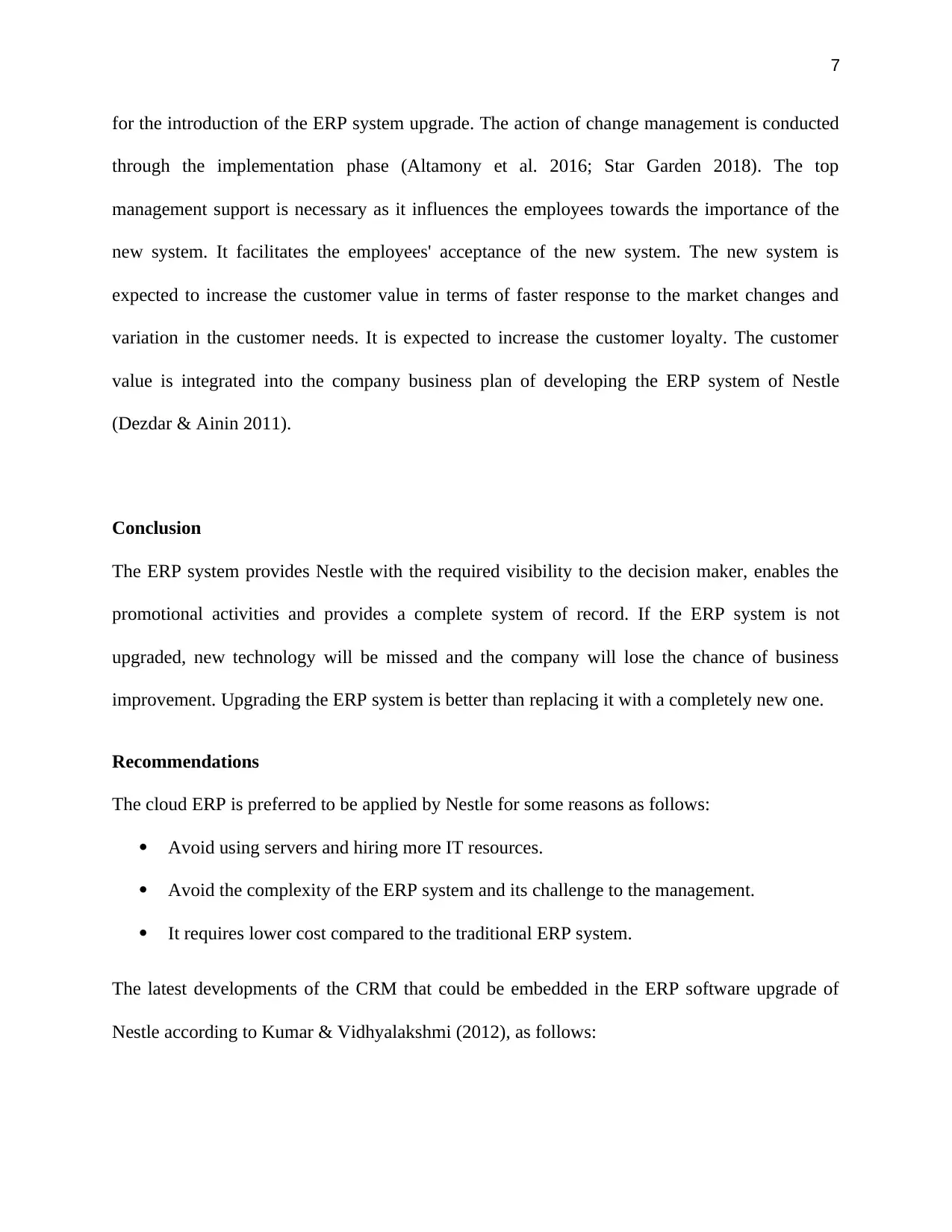
7
for the introduction of the ERP system upgrade. The action of change management is conducted
through the implementation phase (Altamony et al. 2016; Star Garden 2018). The top
management support is necessary as it influences the employees towards the importance of the
new system. It facilitates the employees' acceptance of the new system. The new system is
expected to increase the customer value in terms of faster response to the market changes and
variation in the customer needs. It is expected to increase the customer loyalty. The customer
value is integrated into the company business plan of developing the ERP system of Nestle
(Dezdar & Ainin 2011).
Conclusion
The ERP system provides Nestle with the required visibility to the decision maker, enables the
promotional activities and provides a complete system of record. If the ERP system is not
upgraded, new technology will be missed and the company will lose the chance of business
improvement. Upgrading the ERP system is better than replacing it with a completely new one.
Recommendations
The cloud ERP is preferred to be applied by Nestle for some reasons as follows:
Avoid using servers and hiring more IT resources.
Avoid the complexity of the ERP system and its challenge to the management.
It requires lower cost compared to the traditional ERP system.
The latest developments of the CRM that could be embedded in the ERP software upgrade of
Nestle according to Kumar & Vidhyalakshmi (2012), as follows:
for the introduction of the ERP system upgrade. The action of change management is conducted
through the implementation phase (Altamony et al. 2016; Star Garden 2018). The top
management support is necessary as it influences the employees towards the importance of the
new system. It facilitates the employees' acceptance of the new system. The new system is
expected to increase the customer value in terms of faster response to the market changes and
variation in the customer needs. It is expected to increase the customer loyalty. The customer
value is integrated into the company business plan of developing the ERP system of Nestle
(Dezdar & Ainin 2011).
Conclusion
The ERP system provides Nestle with the required visibility to the decision maker, enables the
promotional activities and provides a complete system of record. If the ERP system is not
upgraded, new technology will be missed and the company will lose the chance of business
improvement. Upgrading the ERP system is better than replacing it with a completely new one.
Recommendations
The cloud ERP is preferred to be applied by Nestle for some reasons as follows:
Avoid using servers and hiring more IT resources.
Avoid the complexity of the ERP system and its challenge to the management.
It requires lower cost compared to the traditional ERP system.
The latest developments of the CRM that could be embedded in the ERP software upgrade of
Nestle according to Kumar & Vidhyalakshmi (2012), as follows:
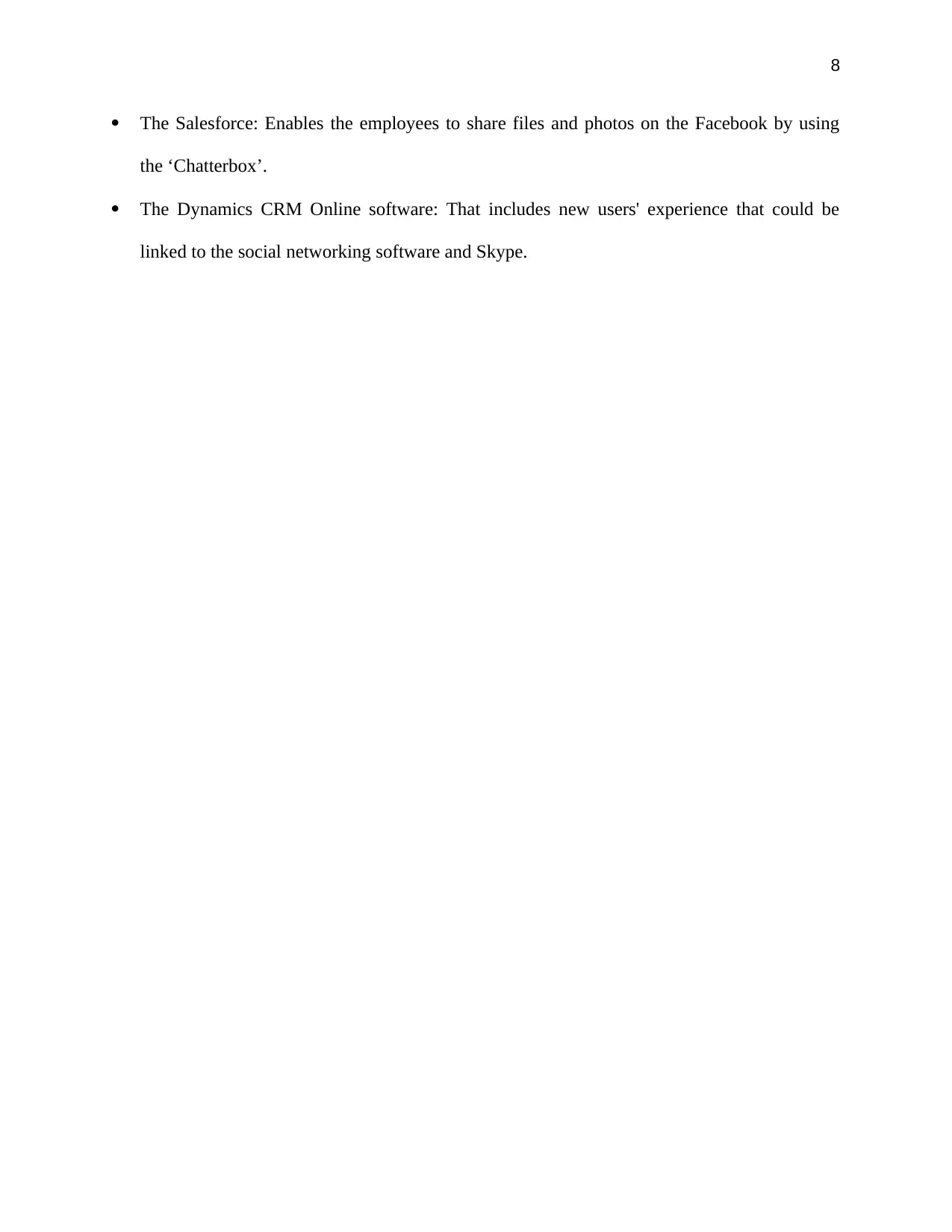
8
The Salesforce: Enables the employees to share files and photos on the Facebook by using
the ‘Chatterbox’.
The Dynamics CRM Online software: That includes new users' experience that could be
linked to the social networking software and Skype.
The Salesforce: Enables the employees to share files and photos on the Facebook by using
the ‘Chatterbox’.
The Dynamics CRM Online software: That includes new users' experience that could be
linked to the social networking software and Skype.
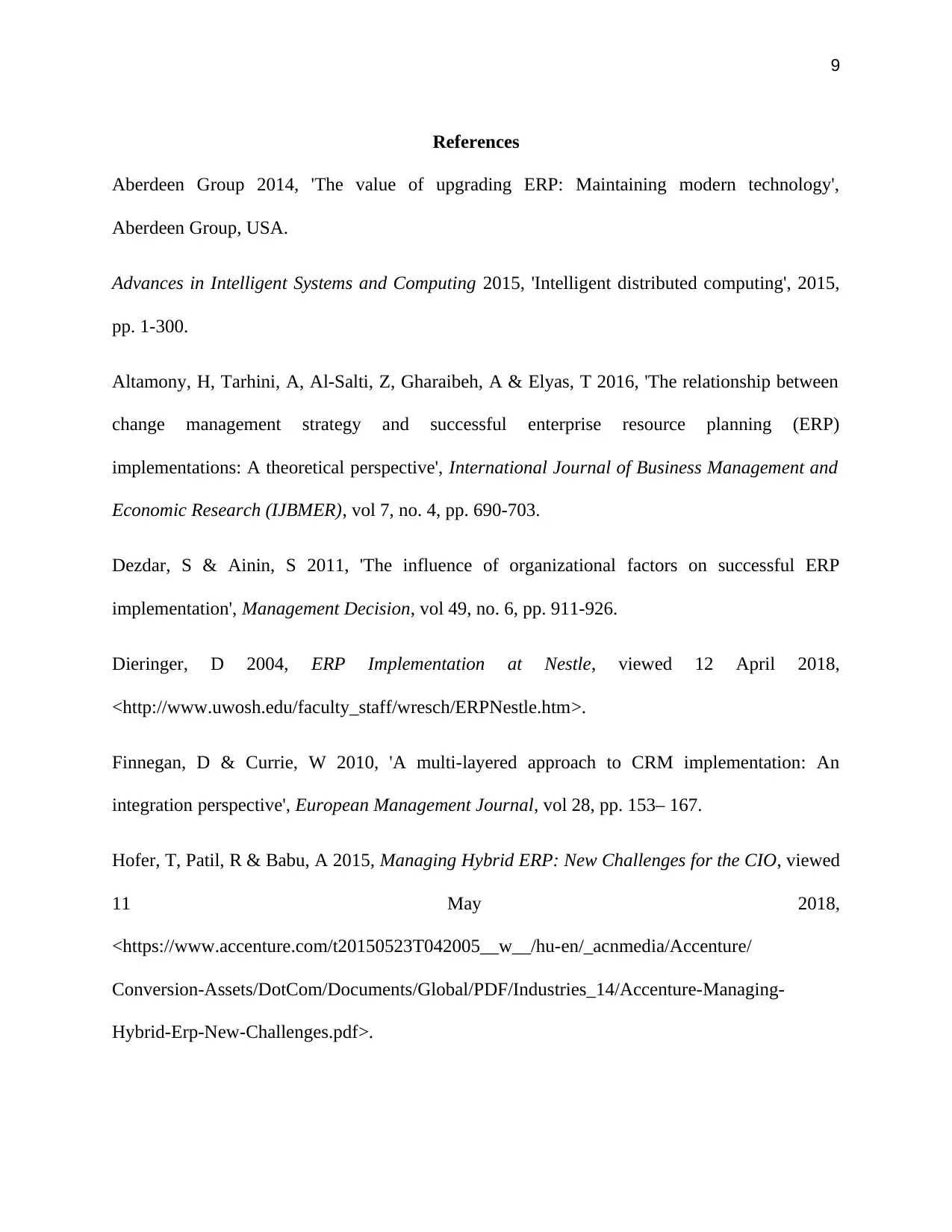
9
References
Aberdeen Group 2014, 'The value of upgrading ERP: Maintaining modern technology',
Aberdeen Group, USA.
Advances in Intelligent Systems and Computing 2015, 'Intelligent distributed computing', 2015,
pp. 1-300.
Altamony, H, Tarhini, A, Al-Salti, Z, Gharaibeh, A & Elyas, T 2016, 'The relationship between
change management strategy and successful enterprise resource planning (ERP)
implementations: A theoretical perspective', International Journal of Business Management and
Economic Research (IJBMER), vol 7, no. 4, pp. 690-703.
Dezdar, S & Ainin, S 2011, 'The influence of organizational factors on successful ERP
implementation', Management Decision, vol 49, no. 6, pp. 911-926.
Dieringer, D 2004, ERP Implementation at Nestle, viewed 12 April 2018,
<http://www.uwosh.edu/faculty_staff/wresch/ERPNestle.htm>.
Finnegan, D & Currie, W 2010, 'A multi-layered approach to CRM implementation: An
integration perspective', European Management Journal, vol 28, pp. 153– 167.
Hofer, T, Patil, R & Babu, A 2015, Managing Hybrid ERP: New Challenges for the CIO, viewed
11 May 2018,
<https://www.accenture.com/t20150523T042005__w__/hu-en/_acnmedia/Accenture/
Conversion-Assets/DotCom/Documents/Global/PDF/Industries_14/Accenture-Managing-
Hybrid-Erp-New-Challenges.pdf>.
References
Aberdeen Group 2014, 'The value of upgrading ERP: Maintaining modern technology',
Aberdeen Group, USA.
Advances in Intelligent Systems and Computing 2015, 'Intelligent distributed computing', 2015,
pp. 1-300.
Altamony, H, Tarhini, A, Al-Salti, Z, Gharaibeh, A & Elyas, T 2016, 'The relationship between
change management strategy and successful enterprise resource planning (ERP)
implementations: A theoretical perspective', International Journal of Business Management and
Economic Research (IJBMER), vol 7, no. 4, pp. 690-703.
Dezdar, S & Ainin, S 2011, 'The influence of organizational factors on successful ERP
implementation', Management Decision, vol 49, no. 6, pp. 911-926.
Dieringer, D 2004, ERP Implementation at Nestle, viewed 12 April 2018,
<http://www.uwosh.edu/faculty_staff/wresch/ERPNestle.htm>.
Finnegan, D & Currie, W 2010, 'A multi-layered approach to CRM implementation: An
integration perspective', European Management Journal, vol 28, pp. 153– 167.
Hofer, T, Patil, R & Babu, A 2015, Managing Hybrid ERP: New Challenges for the CIO, viewed
11 May 2018,
<https://www.accenture.com/t20150523T042005__w__/hu-en/_acnmedia/Accenture/
Conversion-Assets/DotCom/Documents/Global/PDF/Industries_14/Accenture-Managing-
Hybrid-Erp-New-Challenges.pdf>.
Secure Best Marks with AI Grader
Need help grading? Try our AI Grader for instant feedback on your assignments.
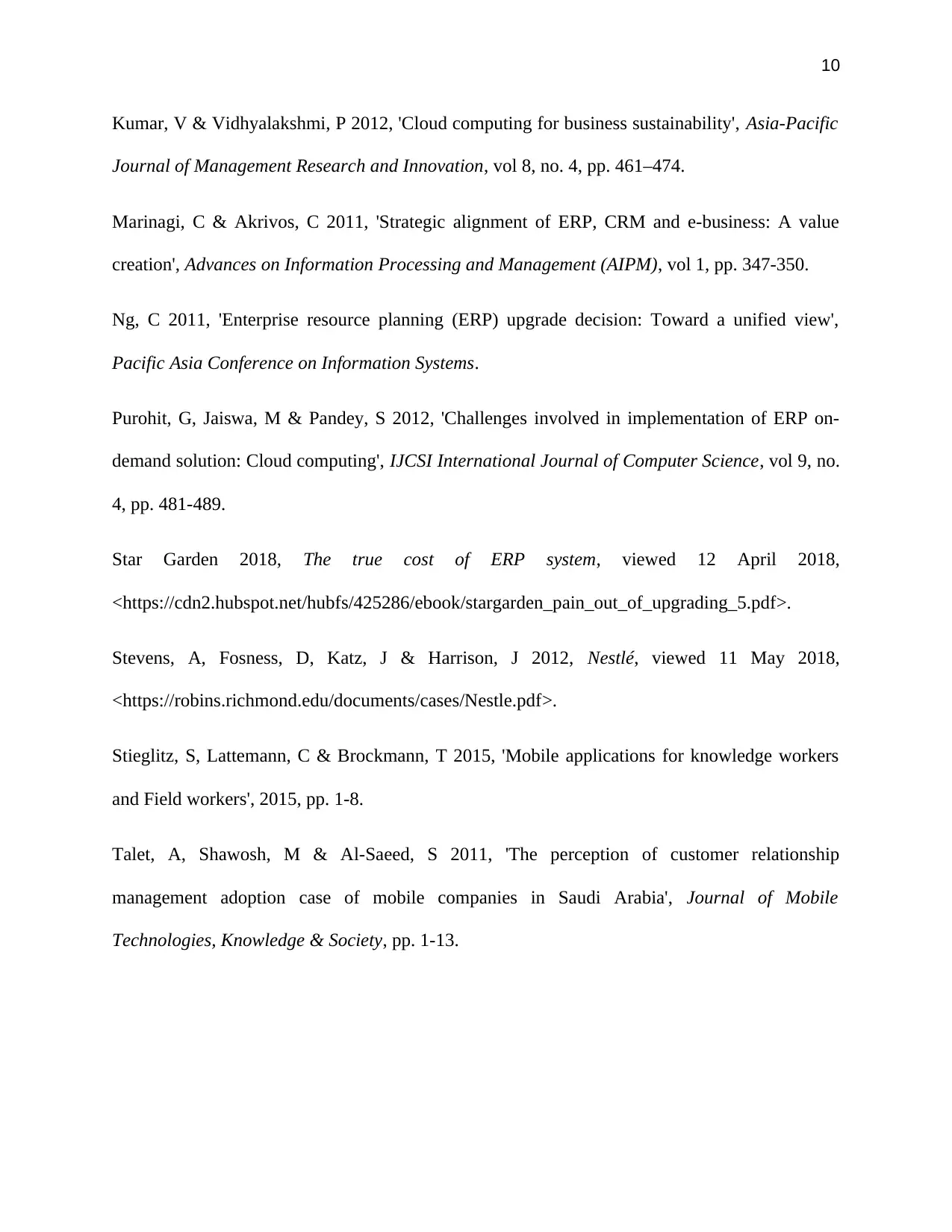
10
Kumar, V & Vidhyalakshmi, P 2012, 'Cloud computing for business sustainability', Asia-Pacific
Journal of Management Research and Innovation, vol 8, no. 4, pp. 461–474.
Marinagi, C & Akrivos, C 2011, 'Strategic alignment of ERP, CRM and e-business: A value
creation', Advances on Information Processing and Management (AIPM), vol 1, pp. 347-350.
Ng, C 2011, 'Enterprise resource planning (ERP) upgrade decision: Toward a unified view',
Pacific Asia Conference on Information Systems.
Purohit, G, Jaiswa, M & Pandey, S 2012, 'Challenges involved in implementation of ERP on-
demand solution: Cloud computing', IJCSI International Journal of Computer Science, vol 9, no.
4, pp. 481-489.
Star Garden 2018, The true cost of ERP system, viewed 12 April 2018,
<https://cdn2.hubspot.net/hubfs/425286/ebook/stargarden_pain_out_of_upgrading_5.pdf>.
Stevens, A, Fosness, D, Katz, J & Harrison, J 2012, Nestlé, viewed 11 May 2018,
<https://robins.richmond.edu/documents/cases/Nestle.pdf>.
Stieglitz, S, Lattemann, C & Brockmann, T 2015, 'Mobile applications for knowledge workers
and Field workers', 2015, pp. 1-8.
Talet, A, Shawosh, M & Al-Saeed, S 2011, 'The perception of customer relationship
management adoption case of mobile companies in Saudi Arabia', Journal of Mobile
Technologies, Knowledge & Society, pp. 1-13.
Kumar, V & Vidhyalakshmi, P 2012, 'Cloud computing for business sustainability', Asia-Pacific
Journal of Management Research and Innovation, vol 8, no. 4, pp. 461–474.
Marinagi, C & Akrivos, C 2011, 'Strategic alignment of ERP, CRM and e-business: A value
creation', Advances on Information Processing and Management (AIPM), vol 1, pp. 347-350.
Ng, C 2011, 'Enterprise resource planning (ERP) upgrade decision: Toward a unified view',
Pacific Asia Conference on Information Systems.
Purohit, G, Jaiswa, M & Pandey, S 2012, 'Challenges involved in implementation of ERP on-
demand solution: Cloud computing', IJCSI International Journal of Computer Science, vol 9, no.
4, pp. 481-489.
Star Garden 2018, The true cost of ERP system, viewed 12 April 2018,
<https://cdn2.hubspot.net/hubfs/425286/ebook/stargarden_pain_out_of_upgrading_5.pdf>.
Stevens, A, Fosness, D, Katz, J & Harrison, J 2012, Nestlé, viewed 11 May 2018,
<https://robins.richmond.edu/documents/cases/Nestle.pdf>.
Stieglitz, S, Lattemann, C & Brockmann, T 2015, 'Mobile applications for knowledge workers
and Field workers', 2015, pp. 1-8.
Talet, A, Shawosh, M & Al-Saeed, S 2011, 'The perception of customer relationship
management adoption case of mobile companies in Saudi Arabia', Journal of Mobile
Technologies, Knowledge & Society, pp. 1-13.
1 out of 11
Related Documents
Your All-in-One AI-Powered Toolkit for Academic Success.
+13062052269
info@desklib.com
Available 24*7 on WhatsApp / Email
![[object Object]](/_next/static/media/star-bottom.7253800d.svg)
Unlock your academic potential
© 2024 | Zucol Services PVT LTD | All rights reserved.




